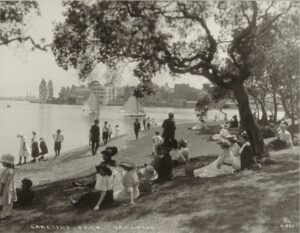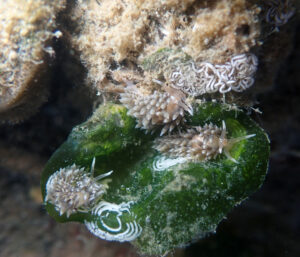From whale-watching expeditions to wildflower forays, naturalist David Wimpfheimer takes great pleasure in leading people on what he likes to call natural “treasure hunts.” A biologist and naturalist with a particular passion for birds and the natural history of California, David looks forward to the annual Christmas Bird Count, a nationwide “citizen science” event in which birders tally as many species as they can over the course of one day during the holiday season.
For the past 25 years, he has taught classes and led outings for Point Reyes Field Seminars, Elderhostel, the Oceanic Society, Dolphin Charters, and the California Academy of Sciences – both throughout California and further afield, including Alaska, Scotland, and Baja California.
BN: What originally inspired you to become a naturalist?
DW: I grew up in New York City, with minimal exposure to nature. But then my life was changed forever when I traveled to Alaska and other parts of the West as a teenager. In the mid 1970s I was really influenced by the environmental movement, which made me want to be more fully connected with the natural world. My desire to help create a new awareness of this world for others, and to have their lives enriched in the same way mine was, inspired me to become a naturalist.
BN: What brought you to the Bay Area?
DW: I arrived in the Bay Area in March, 1980 to work as a naturalist at Point Reyes National Seashore. I had a very rich and diverse position: I gave tours of the historic lighthouse; presented programs on whales, geology, and birds, led beach walks and tours of Kule Loklo (the replica Coast Miwok village); and offered campfire programs. I loved the amazing diversity of the area, and that led to a love of California with all its richness. I fell in love with it and never left! Even though I no longer work at the park, I still live “next door,” in Inverness.
BN: I gather you’re involved with the Christmas Bird Count. Tell us about that event.
DW: This year I’m involved in a number of Christmas Bird Counts around the Bay Area, including the Christmas Bird Count for Kids at Point Reyes in January. This year the bird count season runs from December 14 – January 5th. That means that starting next week I’m going to be out at 4:30 in the morning listening for owls and then birding hard all day.
BN: Can you give us a little bit of history about the CBC?
DW: It’s a tradition that started on Christmas Day 1900, when an ornithologist named Frank Chapman proposed a new holiday tradition: Instead of hunting birds on Christmas Day, he suggested counting them for 24 hours as a less destructive way to enjoy nature. The CBC started with six counts; now there are over 2,200, including at least twenty in the Bay Area. It’s the largest citizen-science effort in the world. And it’s a great way to discover the outdoors, a treasure hunt where you can always find something new or different.
BN: How useful is the data that comes from the Christmas bird counts?
DW: The data can give us a snapshot of the health of a particular population. For example, last year we counted 29 peregrine falcons at Point Reyes. Why so many? Because they like to eat ducks and sandpipers, and there are a lot of those birds in Tomales Bay and other local estuaries. Up until the early 1970s peregrines were decimated by DDT, but following the banning of DDT, the population was restored through a captive breeding program. You can also get an idea of the impact that loss of habitat has on birds. The populations of loggerhead shrike and burrowing owl are tied into grasslands. Recent counts show that both have declined, mainly in response to reduced habitat.
BN: Tell us more about the child-friendly bird count event.
DW: The goal of “CBC for Kids” is to have fun, connect families with nature and potentially create a “home team” of birders for future bird counts. Children and families are often not included in bird counts – it’s hard for kids to count accurately. So this is an effort to start training future generations for this nationwide endeavor to document the health of our avian communities. It’s only a few hours – a gentle introduction, but it can get children excited about birds and teach them something they can do for the rest of their lives.
There will also be a baby bird camp for 3-7 year olds, with fun bird activities and a short walk. We will not turn children away!
BN: Have you ever done a “Big Year”?
DW: I’m doing a “green” big year now. That means I’m keeping a list of birds I’ve seen walking or biking. I’ve seen 246 species so far this year using “human power.” Because I live in Inverness, close to many bird-rich habitats, I can see a lot of birds fairly easily. However, to add a white-breasted nuthatch to the list I had to make a 50-mile round-trip on my bike. Because I’m expending quite a bit of physical energy I appreciate it more than if I just drove 40 minutes. And, of course, it’s good exercise.
BN: What are some of your favorite natural places around the Bay Area to see and photograph birds?
DW: Bolinas Lagoon and Bodega Bay are great places to shoot photos of birds – and very accessible, because they are right off Hwy 1. Kayaking in Drake’s Estero is another great way to get close to a lot of birds. As for more urban areas, Lake Merritt in Oakland is a great place to photograph ducks, as are the Las Gallinas sewage treatment ponds in San Rafael and Shollenberger Park in Petaluma.
>> To learn more about David Wimpfheimer’s natural history tours, visit:
>> For a schedule of Christmas Bird Counts around the state, click here.
>> Learn about the Christmas Bird Count for Kids

.jpg)



